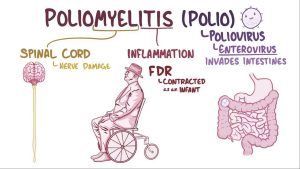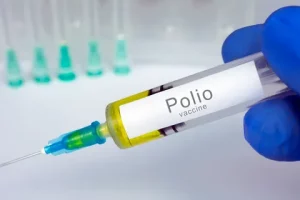Introduction
In today’s modern world, where sanitation infrastructure is a cornerstone of public health, the presence of poliovirus in sewer systems remains a persistent concern. Despite significant advancements in sewage treatment and disease prevention, the threat of poliovirus transmission through sewage persists, posing risks to communities worldwide. Understanding the dangers associated with poliovirus in sewer systems is paramount to implementing effective control measures and safeguarding public health. Explore More About Human Health (Soothing Trembling hands solution)
What is Poliovirus?
Poliovirus, the causative agent of poliomyelitis or polio, is a highly contagious virus that primarily affects young children. It spreads through person-to-person contact, primarily via the fecal-oral route, making sewage an ideal medium for transmission. Poliovirus can survive in sewage for extended periods, retaining its infectivity and posing a significant risk of transmission if proper sanitation measures are not in place.

The Persistence of Poliovirus in Sewer Systems
Sewer systems serve as conduits for transporting wastewater from households, industrial facilities, and other sources to treatment plants. However, despite treatment processes aimed at removing pathogens, including viruses, from sewage, poliovirus can persist in sewer systems due to various factors:
1. Inadequate Sanitation Infrastructure
In regions with insufficient sanitation infrastructure or poorly maintained sewer systems, the risk of poliovirus contamination is heightened. Cracks, leaks, or overflow incidents in sewer pipes can lead to the release of untreated sewage into the environment, facilitating the spread of poliovirus to water bodies and surrounding areas.
2. Incomplete Viral Inactivation
Although sewage treatment plants employ various methods such as chlorination, ultraviolet (UV) irradiation, and filtration to inactivate pathogens, including poliovirus, these processes may not always be 100% effective. Factors such as variations in treatment efficacy, suboptimal operating conditions, and the presence of organic matter can compromise viral inactivation, allowing poliovirus to persist in treated sewage effluent.
3. Urbanization and Population Density
Rapid urbanization and high population density exacerbate the challenges associated with controlling poliovirus in sewer systems. Urban areas with dense populations generate larger volumes of sewage, increasing the likelihood of viral contamination and transmission. Moreover, inadequate waste management practices in densely populated urban centers can further contribute to the dissemination of poliovirus through sewage.
Risks to Public Health
The presence of poliovirus in sewer systems poses significant risks to public health, including:
1. Waterborne Transmission
Contaminated sewage can infiltrate drinking water sources, leading to waterborne transmission of poliovirus. Consumption of contaminated water or ingestion of food washed with contaminated water can result in poliovirus infection, particularly in communities with limited access to clean drinking water and inadequate sanitation facilities.
2. Environmental Contamination
Poliovirus discharged into the environment via sewage can contaminate soil, surface water, and agricultural produce. Direct contact with contaminated soil or water, as well as consumption of crops grown in contaminated soil or irrigated with contaminated water, can contribute to the spread of poliovirus within communities.
3. Outbreak Potential
In areas where poliovirus circulates undetected in sewer systems, the risk of localized or widespread outbreaks remains significant. Factors such as population immunity levels, vaccination coverage, and surveillance capabilities influence the likelihood and severity of polio outbreaks resulting from sewage-associated transmission.

Mitigating the Risks
Effective control and mitigation strategies are essential for minimizing the risks associated with poliovirus in sewer systems:
1. Enhanced Sanitation Measures
Investments in upgrading and maintaining sanitation infrastructure, including sewerage systems and wastewater treatment plants, are critical for reducing the transmission of poliovirus through sewage. Regular inspection, repair, and maintenance of sewer networks can help prevent leaks and minimize environmental contamination.
2. Water Quality Monitoring
Routine monitoring of water quality in both sewage effluent and receiving water bodies is essential for detecting and controlling poliovirus contamination. Advanced analytical techniques, including molecular methods for viral detection, can aid in identifying potential sources of viral pollution and guiding remedial actions.
3. Public Awareness and Education
Raising awareness about the risks of poliovirus transmission through sewage and promoting hygienic practices can empower communities to protect themselves from infection. Educational campaigns emphasizing the importance of hand hygiene, safe water management, and vaccination against polio can help reduce the incidence of sewage-associated poliovirus transmission.
4. Vaccination Programs
Sustaining high vaccination coverage against poliovirus is fundamental for preventing outbreaks and interrupting transmission chains. Routine immunization programs targeting infants and children, supplemented by periodic vaccination campaigns in high-risk areas, play a pivotal role in maintaining population immunity and preventing polio resurgence.

Poliovirus Transmission Risks
| Aspect | Risk Associated |
|---|---|
| Sanitation Infrastructure | Inadequate systems increase the risk of viral contamination |
| Viral Inactivation Efficiency | Variability in treatment effectiveness may allow poliovirus to persist in treated sewage effluent |
| Urbanization and Population Density | Densely populated areas are more prone to sewage-associated transmission of poliovirus |
| Waterborne Transmission | Contaminated water sources can facilitate the spread of poliovirus through consumption or contact |
| Environmental Contamination | Soil, surface water, and crops may become contaminated, contributing to community-wide transmission |
| Outbreak Potential | Undetected poliovirus in sewer systems poses a risk of localized or widespread outbreaks |
Conclusion
The presence of poliovirus in sewer systems poses multifaceted challenges to public health, necessitating comprehensive strategies for risk mitigation and control. By addressing gaps in sanitation infrastructure, implementing rigorous monitoring protocols, and fostering community engagement, we can mitigate the risks associated with sewage-associated poliovirus transmission and safeguard the health and well-being of populations worldwide.












